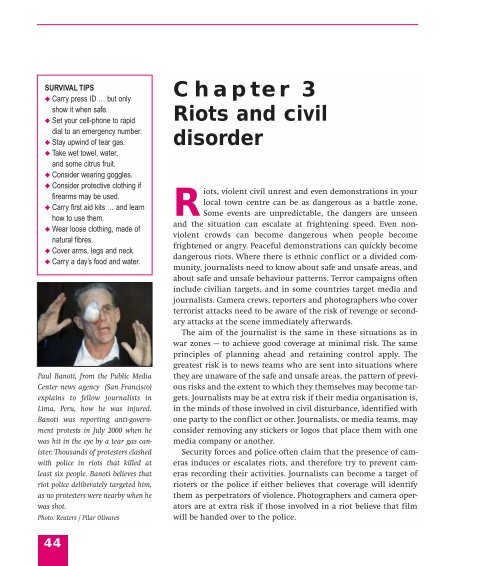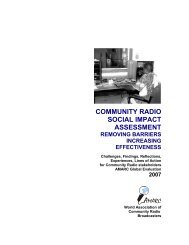Live News - A Survival Guide - International Federation of Journalists
Live News - A Survival Guide - International Federation of Journalists
Live News - A Survival Guide - International Federation of Journalists
- No tags were found...
Create successful ePaper yourself
Turn your PDF publications into a flip-book with our unique Google optimized e-Paper software.
SURVIVAL TIPS◆ Carry press ID … but onlyshow it when safe.◆ Set your cell-phone to rapiddial to an emergency number.◆ Stay upwind <strong>of</strong> tear gas.◆ Take wet towel, water,and some citrus fruit.◆ Consider wearing goggles.◆ Consider protective clothing iffirearms may be used.◆ Carry first aid kits … and learnhow to use them.◆ Wear loose clothing, made <strong>of</strong>natural fibres.◆ Cover arms, legs and neck.◆ Carry a day’s food and water.Paul Banoti, from the Public MediaCenter news agency (San Francisco)explains to fellow journalists inLima, Peru, how he was injured.Banoti was reporting anti-governmentprotests in July 2000 when hewas hit in the eye by a tear gas canister.Thousands <strong>of</strong> protesters clashedwith police in riots that killed atleast six people. Banoti believes thatriot police deliberately targeted him,as no protesters were nearby when hewas shot.Photo: Reuters / Pilar OlivaresChapter 3Riots and civildisorderRiots, violent civil unrest and even demonstrations in yourlocal town centre can be as dangerous as a battle zone.Some events are unpredictable, the dangers are unseenand the situation can escalate at frightening speed. Even nonviolentcrowds can become dangerous when people becomefrightened or angry. Peaceful demonstrations can quickly becomedangerous riots. Where there is ethnic conflict or a divided community,journalists need to know about safe and unsafe areas, andabout safe and unsafe behaviour patterns. Terror campaigns <strong>of</strong>teninclude civilian targets, and in some countries target media andjournalists. Camera crews, reporters and photographers who coverterrorist attacks need to be aware <strong>of</strong> the risk <strong>of</strong> revenge or secondaryattacks at the scene immediately afterwards.The aim <strong>of</strong> the journalist is the same in these situations as inwar zones — to achieve good coverage at minimal risk. The sameprinciples <strong>of</strong> planning ahead and retaining control apply. Thegreatest risk is to news teams who are sent into situations wherethey are unaware <strong>of</strong> the safe and unsafe areas, the pattern <strong>of</strong> previousrisks and the extent to which they themselves may become targets.<strong>Journalists</strong> may be at extra risk if their media organisation is,in the minds <strong>of</strong> those involved in civil disturbance, identified withone party to the conflict or other. <strong>Journalists</strong>, or media teams, mayconsider removing any stickers or logos that place them with onemedia company or another.Security forces and police <strong>of</strong>ten claim that the presence <strong>of</strong> camerasinduces or escalates riots, and therefore try to prevent camerasrecording their activities. <strong>Journalists</strong> can become a target <strong>of</strong>rioters or the police if either believes that coverage will identifythem as perpetrators <strong>of</strong> violence. Photographers and camera operatorsare at extra risk if those involved in a riot believe that filmwill be handed over to the police.44
















